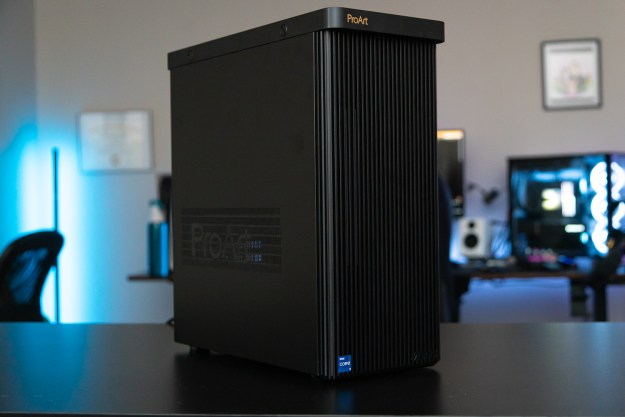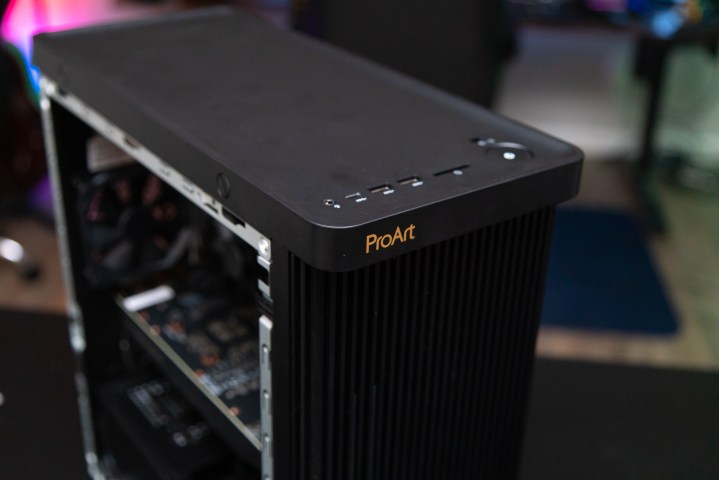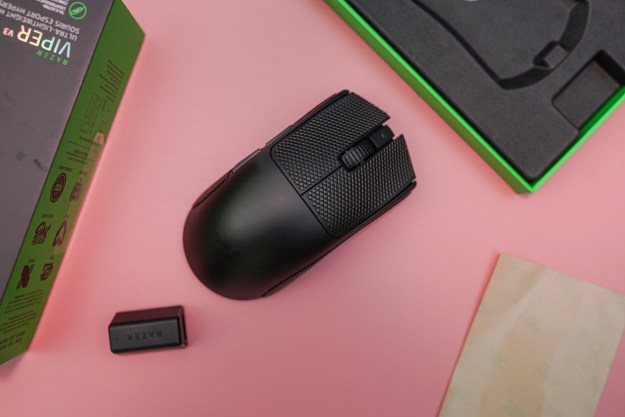
“Looks can't make up for the shortcomings of the Asus ProArt Station PD5.”
- The case looks great
- Solid GPU performance
- ISV certification
- Loud and hot
- Limited room for upgrades
- Uses a last-gen processor
- Underperforms compared to similarly priced PCs
The Asus ProArt Station PD5 is one of the first PCs that explicitly targets creators, as opposed to the barrage of video editing and streaming PCs that are really just gaming desktops. Unfortunately, the PD5 doesn’t make a strong argument for this segment due to its older Intel processor, high thermals, and loud fan noise.
Despite a sleek chassis worthy of our best desktop PC roundup, the PD5 is held back by a last-gen processor that massively underperforms compared to modern offerings. It’s missing many essential features that are available to creators today, all while selling for the same price as desktops with them.
Design

The ProArt Station PD5 looks great, but it doesn’t have a great design. Aesthetically, the narrow lines on the front of the case look fantastic, accented by thin LED strips that can show your CPU/GPU temperature, render times, and more. The ProArt branding is fantastic, and it makes the PD5 look like a truly unique PC.
Function over form has to come into play at some point, though, and the PD5 is dysfunctional. The PC almost seems intentionally designed to keep as much heat in as possible. The front intake vents are thin and don’t bring in enough air, and the exhaust is limited to an 80mm fan in the back and some vents on the side panel. The vast majority of this case is closed off to airflow, and that’s a problem.
The ProArt PD5 seems like it’s trying to be as hot as possible.
It’s even more of a problem considering the components inside. The ProArt PD5 comes with one — count them, one — fan inside: an 80mm exhaust in the back of the case. Asus also uses a thin CPU cooler reminiscent of a stock cooler and a blower-style graphics card. From the case to the internals, the ProArt PD5 seems like it’s trying to be as hot as possible.

The ProArt PD5 looks great, and small touches like a lock on the power button are welcome. But the glitz washes away quickly when the PC sounds like (and gets as hot as) a proper workstation but doesn’t perform like one (read our Lenovo P620 review for a machine that does).
Specs and pricing

The ProArt Station PD5 can sport some serious hardware. You have access to up to a Core i9-11900 for the GPU, an RTX 3070 or RTX A2000 for the GPU, up to 128GB of DDR4-3200 memory, and up to 6TB of storage spread across an SSD and a spinning hard drive.
The problem is the CPU, which is a previous generation offering. Stepping back a generation isn’t great, but it’s worse considering Intel’s 11th-gen platform wasn’t exactly an update enthusiasts were hoping for.
| CPU | Intel Core i7-11700 |
| GPU | Nvidia GeForce RTX 3070 |
| Motherboard | Custom B560 mATX |
| Case | Custom Asus ProArt PD5 mid-tower |
| Memory | 32GB (2 x 16GB) DDR4-3200 |
| Storage | 1TB PCIe 3.0 NVMe SSD |
| Power supply | 500W 80+ Gold |
| USB ports | Front: 2x USB 3.2 Gen 1, 1x USB-C 3.2 Gen 1 / Rear: 4x USB 3.2 Gen 1, 2x USB 2.0 |
| Networking | Gigabit Ethernet, Wi-Fi 6, Bluetooth 5.2 |
Even the most expensive Core i9-11900 is an embarrassing CPU, so the ProArt Station PD5 left me scratching my head. AMD’s Ryzen 5000 options make more sense for creators, and they’re still among the best CPUs in 2022. It’s a missed opportunity considering Asus sells the ProArt X570 Creator Wi-Fi motherboard. What’s worse is that Intel’s 12th-gen platform is significantly faster, and it comes with better features for creators.
It’s really hard to justify the PD5’s specs.
The main one is DDR5. DDR5 would have likely bloated the cost of the ProArt Station PD5, but it offers real advantages in creative apps like Adobe Premiere Pro. Even without DDR5, you’re locked into one of Intel’s worst platforms without the option to upgrade unless you rip the motherboard out.
It’s really hard to justify the PD5’s specs. You can pick up an identically configured Dell XPS Desktop 8950 with Intel’s 12th-gen i7 for less money than what Asus is charging for the PD5. My configuration clocks in at $2,000, though I’ve seen some for as low as $1,700.
I’m not sure how high the machine will scale because higher-end configurations aren’t available right now. I don’t imagine the machine will exceed $3,000, though. It’s not a bad price, but the PD5 is essentially a computer from 2021, not 2022, so modern PCs with a similar price range will always be a better deal.
That could change if Asus updates this machine with 12th-gen options, but at the time of writing, those aren’t available.
Internals and upgradability

The ProArt PD5 offers some room to grow, but not much. You can swap the GPU and RAM, and there are a couple of drive bays at the bottom of the machine. These are tool-less, which is a nice touch. Unfortunately, Asus doesn’t include cables already routed to the bay.
Inside, the case is remarkably small. Asus calls it a “full-sized ATX tower,” but that’s far from the case. You couldn’t even fit a standard ATX motherboard inside the case, and the power supply is shmushed up against the drive bay. There isn’t any room for fans, either, just the single 80mm fan in the back of the case.
Considering the case is one of the worst parts of the ProArt PD5, upgradability is a bit of a moot point. You can, technically, add some hardware to the machine. But you’re so limited by room and thermals that you probably shouldn’t. The machine is locked to Intel’s 11th-gen platform, too, which isn’t compatible with Intel’s modern CPUs.
Performance

The ProArt PD5 would be a solid desktop if it was released a year ago. In 2022, it’s a disappointment. It underperforms across the board, hindered by the weaker eight-core Core i7-11700 that has been surpassed by Intel’s more recent 12th-gen offerings. I included a couple of machines for CPU reference below (even if the HP Omen 45L isn’t really competing with Asus’ machine).
| Asus ProArt PD5 (Core i7-11700) | Dell XPS Desktop 8950 (Core i5-12600K) | HP Omen 45L (Core i9-12900K) | |
| Cinebench R23 multi-core | 8,866 | 16,798 | 23,068 |
| Cinebench R23 single-core | 1,504 | 1,903 | 1,893 |
| Geekbench 5 multi-core | 8,110 | 10,819 | 15,685 |
| Geekbench 5 single-core | 1,639 | 1,829 | 1,910 |
| PugetBench for Premiere Pro | 627 | 708 | 1,025 |
| PCMark 10 | 6,822 | 7,633 | 9,034 |
| Handbrake | 111 seconds | N/A | 51 seconds |
The biggest issue for the ProArt Station PD5 is that it’s based on Intel’s 11th-gen platform. Asus announced the machine in September 2021, just a couple of months before Intel launched its 12th-gen Alder Lake platform. Despite that, machines only started showing up at the beginning of 2022.
The 32GB of DDR4 memory and RTX 3070 graphics card should make the PD5 a solid midrange creator PC, but the hardware is held back by the Core i7-11700. The Dell XPS Desktop 8950 shows that. Even with half of the RAM and a weaker video card (the RTX 3060 Ti), it outperforms the ProArt PD5 by nearly 13% in Premiere Pro and almost 12% in PCMark 10.
Intel’s 12th-gen chips are leaps and bounds ahead of the company’s previous offerings (you can read our Core i9-12900K review for the proof). It’s hard justifying a desktop with hardware that’s out of date, especially when that hardware so clearly underperforms compared to modern offerings.
It’s possible Asus will update the PD5 with the 12th-gen chip, though, which would improve the performance situation a lot. This could be an issue with supply shortages, and Asus could be planning to add 12th-gen options down the road.
Gaming performance

The ProArt PD5 is a creator-focused machine; but let’s be honest, it’d be a shame to not let an RTX 3070 rip through some games. Unfortunately, this machine isn’t the best setting for Nvidia’s GPU (which is among the best graphics cards you can buy). You can see the results I recorded from a few games at 1440p below. I used the highest preset for each game.
| Asus ProArt PD5 (RTX 3070) | MSI Aegis RS 12 (RTX 3070) | Dell XPS Desktop (RTX 3060 Ti) | |
| 3DMark Fire Strike | 22,862 | 28,511 | 24,019 |
| 3DMark Time Spy | 11,929 | 13,545 | 11,400 |
| Red Dead Redemption 2 | 76 fps | 78 fps | 69 fps |
| Assassin’s Creed Valhalla | 71 fps | 76 fps | N/A |
| Forza Horizon 4 | 144 fps | N/A | 148 fps |
Again, the Core i7-11700 is a hindrance. In a one-for-one against the MSI Aegis RS 12 with a Core i7-12700KF, the ProArt PD5 lags. It’s not too bad in GPU-limited titles like Assassin’s Creed Valhalla and Red Dead Redemption 2. The gap is a bit wider at 1080p, but the Asus machine only lagged by around 6% at most.
Forza Horizon 4, which is a little heavier on the CPU, shows a different side of the story. The Dell XPS Desktop 8950 managed to outperform the ProArt PD5 despite using a weaker GPU. Dell’s machine uses the Core i5-12600K, too, not the Core i7-12700K.
Outside of performance. I need to point out temperatures. During a run of Assassin’s Creed Valhalla, the GPU reached 84 degrees Celsius. That’s not a problem in isolation, but the card reached that temperature after about 30 seconds. For long rendering sessions, those kinds of temperatures could cause issues down the line. They’re safe, but you shouldn’t sustain them for hours on end.
Software

Asus is generally good about bloatware — read our Asus ROG GA35DX review for an example — and the ProArt PD5 is no different. For bloat, the machine does come with McAfee Internet Security. It wasn’t too intrusive at first, but keep in mind that programs like McAfee tend to only become annoying once it’s time to renew.
Otherwise, the machine comes with MyAsus for support and the ProArt Creator Hub to customize your machine. I like the Creator Hub. It gives you a solid overview of your system vitals and allows you to adjust the lights on the front of the PD5 to show remaining render times or provide warnings about CPU/GPU temperature.
I particularly like the Work Smart feature, which allows you to create groups of apps that you can launch with a single click. My only issue is that Asus doesn’t surface the ProArt Creator Hub in the same way as MyAsus (which is pinned to the taskbar). Other than that, it’s a great, if simple, piece of software.
Our take
The Asus ProArt Station PD5 is a bad choice for creators in 2022. Although I had issues with the thermals and fan noise, the real killer is the last-gen processor at the heart of the machine. Asus likely wanted to release this machine in 2021 before Intel’s next-gen processors arrived, but the delays have been to the machine’s detriment.
Are there any alternatives?
Yes, but not many right now. The main competitor is the Dell XPS Desktop, which is available with Intel’s newer processors, DDR5 memory, and more powerful GPU options. That said, it lacks ISV certification and access to Nvidia’s workstation GPUs.
How long will it last?
The Asus ProArt Station PD5 should last a few years, but the older Intel platform and limited case room mean that it will wear out its welcome quickly.
Should you buy it?
No. The ProArt Station PD5 may have been an option in 2021, but in 2022, there are machines selling for the same price with newer hardware, better thermals, and lower fan noise.
Editors' Recommendations
- Asus’ new ProArt Studiobook has a glasses-free 3D OLED screen
- Asus’ new color-accurate ProArt OLED monitor comes with built-in colorimeter
- The new Asus ProArt desktop and motherboard look perfect for creators







